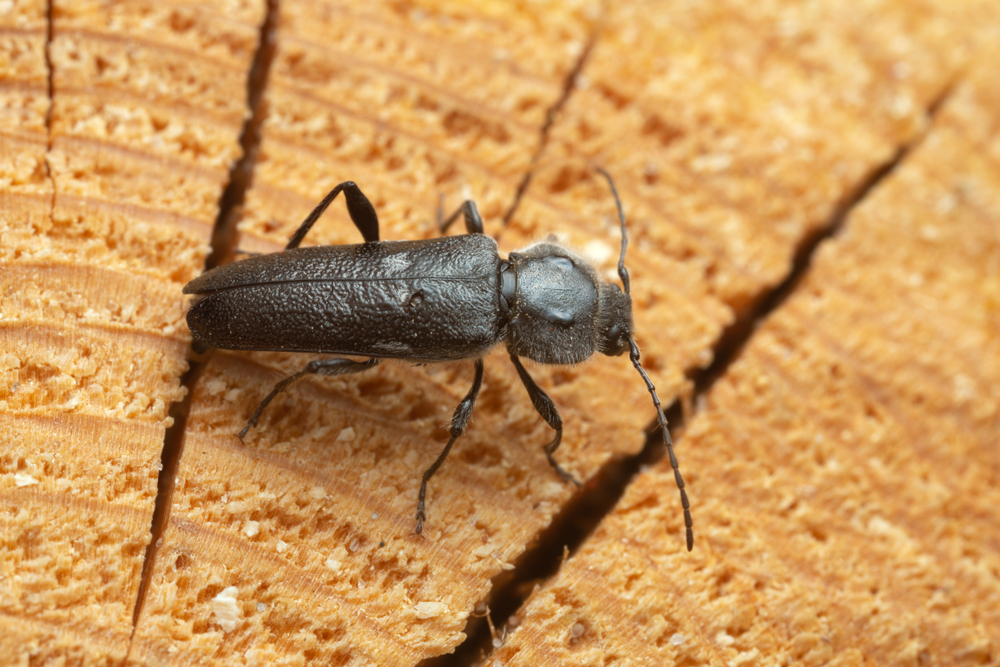Unfortunately, many wood-damaging insects, such as termites and carpenter ants, can live in your home undetected for months and even years. By the time you spot an infestation, irreversible damage may have already occurred to your home.
Therefore, it’s important to identify the signs of wood-eating insects early and learn how to identify and get rid of them once and for all.
This guide will provide a comprehensive overview of several common wood-damaging insects across the US and provide practical tips to prevent and eliminate any infestations that arise at your home.
What are wood-damaging insects?
As their name suggests, wood-damaging insects are insects that damage wood by tunneling through it to live, nest, and feed. And these destructive insects tend to be quite sneaky pests.
 Examples of wood-
Examples of wood-
Examples of wood-damaging insects common to Maryland and other parts of the country include:
- Termites: Termites are small brown insects (½” long) that feed on wood. The most common and destructive termite in the US is the subterranean termite, which lives on the East Coast and is known for its mud tubes and wooden frass it leaves behind. Termites are tan and some are known to have wings–also known as swarmers.
- Carpenter ants: Carpenter ants are one of the largest species of household-invading ants and are mostly black in color, but some species can be a combination of black, red, and yellow in color. Carpenter ants like to nest in water-damaged or decaying pieces of wood.
- Carpenter bees: Carpenter bees are large in size and look similar to bumble bees. Both bumble bees and carpenter bees have yellow and black markings, but carpenter bees are mostly black in color. Carpenter bees are known for their wood-damaging habits, as they tend to borrow holes in softer, untreated wood to make nests for themselves.
- Wood-boring beetles: After termites, wood-boring beetles are the most significant wood-destroying insects. Female wood-boring beetles lay their eggs on wood that has not been seasoned or processed. However, some species will damage seasoned wood. When the larvae hatch from their eggs they burrow into the piece of wood, tunneling through it and feeding on it.
Are wood-damaging insects dangerous?
Wood-damaging insects are not directly dangerous to people but can be dangerous to structures by weakening their integrity.
However, many species of wood-eating insects will not bite or sting you. For example, while female carpenter bees are equipped with a stinger, they are quite docile. The males are aggressive but they lack stingers.
Likewise, carpenter ants and wood-boring insects do not bite, sting, or cause health problems in people.
The main worry is that they can damage your home to such a degree that it becomes unsafe.
Why do I have a wood-damaging insect problem?
Wood-damaging insects, like carpenter ants and bees, often enter homes accidentally while foraging for food sources. Eventually, they may stumble through small cracks and crevices found in your home’s foundation or a crack in the exterior wall and start feasting on the wood framing members.
Other wood-eating insects, such as termites and beetles, will search out homes with exposed timbers, wooden furniture, barn wood, or other wooden items, which they infest with their larvae or eggs.
Signs of wood-damaging insects on your property
To check for signs of wood-damaging insects on your property, it’s a good idea to inspect wooden structures and furniture every now and then for damage. Some signs of wood-eating insects to look for around your home include:
- Small holes in wood: Holes can range in size but are typically the size of the insect and may resemble little pinholes.
- Frass or Swadust: Search for signs of wood debris around wooden structures, including on the steps leading to sheds, basements, or even ledges around windowsills.
- Mud tubes (Termites): Thin mud tubes found on the exterior of your home to an open window or crack will indicate the presence of a termite colony.
- Weakened or hollow-sounding wood: Tap on wood to see if there is any internal damage that may be due to wood-eating insects.
- Discarded wings: Finding discarded wings on windowsills or basement floors may be a telltale sign of a wood-damaging insect infestation.
- Eggs or larvae: Spotting eggs or larvae in or near wood may indicate a brewing infestation. [Learn more: Signs of Termites in Your Home]
Where will I find wood-damaging insects?
Where you will find wood-damaging insects is going to depend on the species of insect inside your home:
- Termites can be found in any area of your home with exposed wood or wooden framing members. This most often includes basements, attics, crawl spaces, rim joists, and garages.
- Carpenter bee females create individual nests in wooden decks, fence rails, wooden trim, wooden play structures, wooden furniture, overhangs, and window sills.
- Carpenter ants nest outside in fallen trees, tree stumps, under mulch, or in wood piles. When nesting inside homes or other buildings, carpenter ants prefer to nest inside structural wood that has been previously damaged by water or that is decaying.
- Wood-boring beetles can be found attacking and invading a variety of materials inside, including sub-flooring, hardwood floors, door and window trim, joists, window sills, and structural beams. They can also be found in barn wood, hardwood furniture, and can become a big issue inside log houses.
How can I prevent wood-damaging insects in the future?
Preventing problems with wood-damaging insects can be difficult. Here are several things you can do in and around your home to deter them:
- Put into place a professional wood-damaging insect control program from Pest Czar.
- Seal cracks and crevices found in your home’s foundation, exterior walls, and spaces found around utilities entering your home from outdoors.
- Repair leaky pipes, fixtures, and faucets found inside and outside your home.
- Remove structural wood from your property that has been damaged by water.
- Make sure that the wood you are purchasing has been properly stored and dried.
- Paint or stain exposed bare wood in your home to help prevent wood-boring beetles.
- Paint, stain, or otherwise treat wooden structures on your property.
- Limit the use of old barn wood inside your home.
- Inspect antiques made of wood before bringing them into your home.
How do I get rid of wood-damaging insects?
Several store-bought products and DIY solutions can help you get rid of wood-eating insects, including termiticides and insecticides.
However, to truly eliminate destructive wood-damaging insects from your home or property and prevent a re-infestation, partner with a knowledgeable professional. At Pest Czar, our local and experienced professionals can provide the comprehensive pest control services needed to get rid of the wood-damaging insects living in your home or on your property. We can then prevent their return by implementing one of our GreenPro-certified pest protection plans. For exceptional, eco-friendly wood-damaging insect control in the Baltimore Metro area of Maryland, give us a call at Pest Czar!
FAQs: Wood-Damaging Insects
Can I prevent infestations without chemicals?
The easiest way to prevent an infestation of wood-eating insects is to seal up any gaps or cracks that physically prevent them from entering your house. Otherwise, conducting frequent inspections will yield the best results.
What are the signs of a severe infestation?
Signs of a severe infestation may include significant damage to wooden structural components, leading to bouncy subfloors, buckling wood, or even collapsing framing members.
How often should I schedule professional inspections?
We recommend conducting a pest inspection quarterly, though an annual inspection in the spring or summer will allow you to catch an infestation early enough before it spreads.
Get Started Today with a Free Quote
Complete the form below to schedule your no obligation inspection.
- Zero-Contact Service
- Same-Day Inspection/Service
- Real-Time Notifications

Customer Reviews
“Joe is knowledgeable and professional. Thanks for the great service!”
Adam | Reisterstown, MD | Read Reviews


